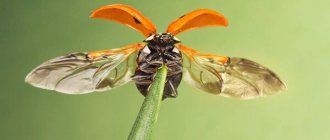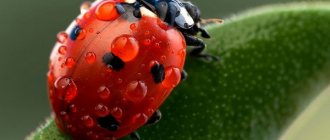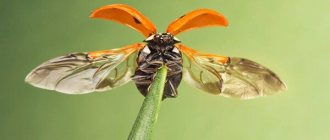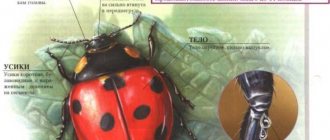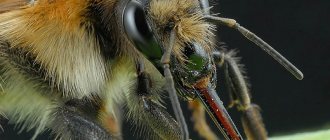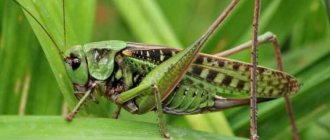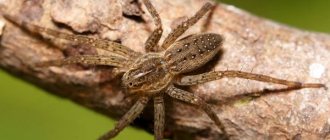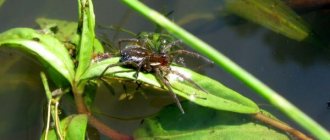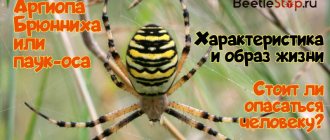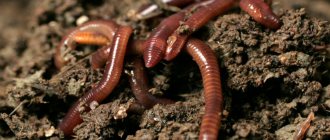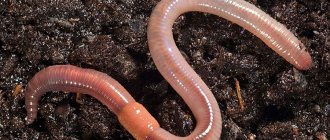The ladybug is an extremely common insect, most often having a bright spotted color. The ladybug family (Coccinellidae) includes a huge number of species - about 8000 (approximately 360 genera). Most of them are beneficial to humans because they feed on certain pests.
Ladybug, appearance of a typical representative of the family
Why is the ladybug called that?
There are two versions of why the insect got its name. The first is that the “ladybug” began to be called “ladybug” because it secretes poisonous milk, and “ladybug” because it has a peaceful disposition. Another version is that the insect began to be called “God’s” because of its ability to destroy aphids, thereby helping to preserve the crop.
The world loves and appreciates the ladybug because most of its species help destroy pests. People's good attitude is also reflected in the way they call this beetle. For example, in Germany and Switzerland the ladybug is called the “Virgin Mary’s bug”, in the Czech Republic and Slovenia – the “sun”, in Latin American countries – the “St. Anthony’s bug”.
By the way, the insect received the Latin name “Coccinellidae” for its unusual bright color: the Latin word “coccineus” is translated as “scarlet”.
External features of a ladybug
The body is oval or round-oval, less often oblong. Strongly convex on top, almost hemispherical or ovoid, the lower part of the body is almost flat. Body length is from 0.8 to 18 mm, usually 4-7 mm. The smallest are representatives of the genus Carinodulinka. The genus Megalocaria has the largest size. In most cases, the insect's body is naked, in some species it is covered with small, inconspicuous hairs.
The head is short and small. The eyes are large. The length of the antennae can vary significantly, but they always consist of 8-11 segments. They have a club-shaped shape. The mouthparts are gnawing type. The upper jaws are clearly visible and sickle-shaped.
The mesothorax is movably connected to the prothorax and immobile to the metathorax. The pronotum is usually widened at the base and rounded, wider than the head, the mesothorax in most species is straight, and the metathorax is wide and almost square. The elytra of representatives of this family are rounded. The wings are wide and long. It should be noted that in some species of ladybugs they are reduced. The limbs are moderately long, well developed, covered with short dense hairs.
Most often, these beetles are very noticeable due to their bright coloring, which is similar to the warning coloration of poisonous insects. It can appear in various combinations of red, yellow, brown, white and black, usually with black spots on a mostly light background. As the insect ages, its color fades. Sexual dimorphism is very weakly expressed. In rare cases, a female can be distinguished from a male by the pattern on the pronotum.
Stages of ladybug development: imago, larva, pupa
Ladybug larvae have an elongated body and 3 pairs of well-developed legs. Their coloration and body shape can vary greatly depending on the species. The minimum length of the larvae is 0.5 mm, and the maximum is 18 mm. Typically, young larvae are quite pale in color; as the insect develops, it becomes brighter.
Types of ladybug
The species belonging to this family differ both in appearance and in their lifestyle. Let's look at some of them.
Seven-spotted ladybird (Coccinella septempunctata)
The seven-spotted ladybug is the most widespread in Europe. The length of the beetle reaches 5-8 mm. The elytra of representatives of this species are red or tan in color. They also have 7 black dots. The larva is bluish-gray with yellow or orange spots.
Sixteen-spotted Galicia (Halyzia sedecimguttata)
The length varies from 5 to 7 mm. The body is oval in shape. The eyes are black. The antennae are light brown, slightly thickened at the end. The elytra are orange, covered with 16 large spots of white or light beige. The edges of the elytra and pronotum are slightly transparent.
Ladybug (Anatis ocellata)
Body length is 8-10 mm. The head and pronotum are black. The elytra are yellow or reddish, each with ten or fewer black spots, which are usually edged with cream. In some cases, the spots are connected in the longitudinal or transverse direction, or less often they are absent.
Two-spot ladybird (Adalia bipunctata)
Body length 3.5-5.5 mm. The body is oblong-oval, moderately convex. Coloring and pattern can vary greatly. Most often there are individuals with red elytra. Ladybugs are also found in pale orange and yellow colors. Each elytron has one large black spot. Separately, it is worth noting insects with black colored elytra. In such representatives of the species, the spots have a bright red tint.
Alfalfa twenty-four-spot ladybird (Subcoccinella vigintiquatuorpunctata)
The body reaches a length of 3-4 mm. It has a red or dark orange color with 20-26 dark spots on the elytra and pronotum. Sometimes the spots may merge or be absent. In rare cases they are yellow.
Asian ladybug (Harmonia axyridis)
The species is native to Asia and was introduced to Europe and North America to control aphids and scale insects. Body length reaches 7 mm. Includes two subspecies: one has yellow elytra with black spots, a white prothorax with a dark pattern, and the other has black elytra with red-orange spots, a black prothorax with light yellow spots. This species has 19 spots on the elytra.
Thirteen-spotted ladybird (Hippodamia tredecimpunctata)
The species includes three subspecies: two are common in Europe and Asia, and one is found in North America. The body is slightly elongated, the length is 4.5-7 mm. The ladybug's elytra are red-brown in color and have 13 black dots on them, which can merge with each other.
Fourteen-spotted ladybird (Propylea quatuordecimpunctata)
The insect's body length varies from 3.5 to 4.5 mm. The elytra are brown, light orange or yellow in color. It has spots of contrasting color (if the elytra are dark, then the spots are cream or white, and if the elytra are light, then the spots are brown or black). Usually there are 14 black dots on the elytra, which merge with each other.
Ladybug (Hippodamia variegata)
This species is common in Europe and introduced to North America. The length of the beetle is 3-5.5 mm. The elytra are yellow-red, have 6 dark spots of various shapes (some may merge or be absent) and one common large scute spot. The pronotum is black with a yellow border and often with two yellow spots.
Spotless ladybird (Cynegetis impunctata)
Quite a rare species that can reach 3-4.5 mm in length. Color varies from brownish-yellow to red. The head is black. There are no spots. The body is covered with fine hairs.
Clitostethus arcuatus
The body length of the beetle is only 1.2-1.4 mm in length. The body is short oval. The elytra are dark yellow or pale brown with a black pattern. Less common are individuals with black elytra, on which there are one or two crescent-shaped spots.
Potato ladybird (Henosepilachna vigintioctopunctata)
The species is native to Southeast Asia, but has been introduced to other parts of the world, including Australia and New Zealand. Reaches 7 mm in length. The body is round in shape. The antennae are quite long, consisting of 11 segments. The elytra, pronotum and head are rich red in color, sometimes with an admixture of red. The entire body of the insect is covered with light hairs. The spots are black, located on the pronotum (the number may vary, in some individuals they are absent) and the elytra (14 points each). This species is a pest because it feeds on agricultural crops: potatoes, pumpkin, turnips, radishes, beans, spinach, etc.
Mexican bean beetle (Epilachna varivestis)
Found in Mexico and the eastern United States. The size of the beetle reaches 6-7 mm. The elytra can be from golden yellow to bright red. There are 8 spots on each elytra. This species is a pest because it feeds on plants of the legume family (beans, clover, soybeans, alfalfa, etc.).
Lifestyle of a ladybug
Ladybugs lead a solitary lifestyle. Depending on the living conditions, the insect lives from several months to a year. Some individuals live up to 2 years. When cold weather sets in, ladybugs form large clusters under fallen leaves, tree bark or stones. There they remain until the beginning of spring. Creating groups like these helps maintain temperatures above ambient. Some species migrate to warmer zones. Under unfavorable conditions, the beetle can fly over considerable distances.
Nutrition
Most species feed on small insects. Their diet consists of aphids, scale insects, small caterpillars, pupae of other insects and butterfly eggs. Ladybug larvae are also most often predators. Some ladybugs feed only on plant foods: these include the Mexican bean beetle and the potato ladybug. In this case, herbivorous species usually prefer plant leaves.
Natural enemies
Ladybugs repel most predators with their bright colors and unpleasant taste. As a defense, beetles can secrete caustic hemolymph, which is red or brownish in color. For this reason, birds and lizards rarely eat ladybugs.
Insects at the adult stage can be affected by entomopathogenic fungi of the genus Boveria. The larvae and pupae are parasitized by various insects, including braconids (a family of parasitic ichneumonids), humpbacks, and horseflies (the family belongs to the suborder of bedbugs).
Reproduction
The breeding season most often occurs in spring or early summer. During the mating period, the female emits a specific odor that attracts the male. After fertilization, the female lays eggs on plants near the largest amount of prey to provide food for the offspring. In this case, eggs are laid on the leaves or branches of plants in small piles. A clutch can contain up to 400 eggs. After the mating season, the females die.
Ladybug eggs are oval in shape, with slightly tapered tips. The surface may be wrinkled. Eggs come in white, yellow and orange. The egg stage takes 1-2 weeks.
Insect larvae are very active and can rise to a height of up to 12 meters in search of food. The development of the beetle at this stage most often takes 4-7 weeks. Pupation occurs on plant leaves. The pupal stage lasts 7-12 days. On average, ladybugs reach sexual maturity at the age of 3-6 months.
The photo shows larvae and pupae of different types of ladybugs, so they differ in appearance.
WHERE IT IS FOUND
Ladybugs can be found throughout the year (for example, if you dig up the dry leaves under which they hide during the cold season), but you can see them without making any effort only in spring, summer and early autumn. In winter they hibernate. At this time of year, entire groups of ladybugs protect themselves from the cold in secluded places, for example under the bark of a tree. In summer, they can most often be found on roses, cherries and other garden plants affected by aphids. Taking a closer look at the plants, you can see the testicles of ladybugs. Ladybug larvae live openly on plants. In winter, you can find the seven-spotted ladybug among the needles of coniferous trees.
The benefits and harms of ladybugs for humans
Most types of ladybugs are beneficial to humans because their diet consists of pests. Predatory insects are capable of eating huge numbers of aphids in a short time (up to 100 individuals). For this reason, ladybugs are often introduced to reduce pest numbers.
However, some species of this family are pests. Herbivorous insects are also distinguished by their gluttony and high reproduction rate. The potato borer, for example, causes significant damage to plants of the nightshade family, especially potatoes. The larvae of such species feed on plant foods, just like adults. This leads to slower crop growth, reduced yields and even plant death.
Can a ladybug bite?
Most species of ladybug pose no threat to humans or pets. The bite of these insects causes only mild skin irritation, which quickly passes. But the Asian ladybug or harlequin should be highlighted separately. The original habitat of the insect was Asia. However, due to the species' high effectiveness in pest control, it was introduced into Europe and North America. At the moment, the Asian ladybug is widespread and is causing the decline in the numbers of other species. The beetle has extremely varied colors on its elytra, which is why it is often confused with other ladybugs.
A harlequin bite is dangerous because it can cause a severe allergic reaction. One of the main symptoms is severe swelling. Asian ladybug bites can also cause:
- nausea;
- movement coordination disorders;
- itching;
- tachycardia.
In addition, a cow with 28 spots can bite a person.
What does it eat?
Most ladybugs feed primarily on aphids. Aphids are soft-bodied, defenseless insects that suck juices from plants. Some types of ladybugs eat scabies mites that harm plants.
Aphids are slow and weak, so the cow does not need special devices to hunt them. The larva of this beetle eats more than the adult, and if there is a lack of aphids, it can feed on other larvae. The jaws of the larvae are the same as those of the adult.
Is the ladybug listed in the Red Book?
Despite the fact that the ladybug is widespread almost all over the world, has a huge number of species, in many countries it is listed in the Red Book, including Russia.
The reason for the decline in the ladybug population is that people are actively fighting the insects that make up its diet, because they are pests, and they actively use chemicals to combat them, which are also harmful to the ladybug. That is, to get rid of pests, people destroy their natural enemies - ladybugs.
How birds sleep
Birds that spend the night not in tree branches practically sleep standing up.
Why don't they fall to the ground? Birds have a long tendon, about the same length as the bird's leg, connected to a strong muscle. When the bird sits, the tendon stretches, acts on the fingers, and they compress, covering the branch. Many birds sleep with their heads tucked under their wings and their feathers raised to protect them from the cold. Herons and storks often sleep standing on one leg. Some parrots in South America sleep in an original way. They hang upside down, clinging to a branch with one leg. Some swifts sleep in a large ball.
Bird sleep is associated with some special metabolic issues. In birds, metabolism is very intense. The normal temperature of birds is 42 C, that is, the temperature that a person experiences only with a serious illness. During sleep, chemical processes in the birds' bodies slow down, and body temperature drops to 20 C.
Many water birds sleep "float". Often ducks and swans are captured by ice: while they sleep, the water around them freezes. Seagulls also sleep on the water. They claim that they can fall asleep for a short time during flight. The ability to sleep in flight is also attributed to birds that can make long flights, such as albatrosses. This may be true, but albatrosses undoubtedly spend most of their sleep on the water. Some animals sleep underwater.
